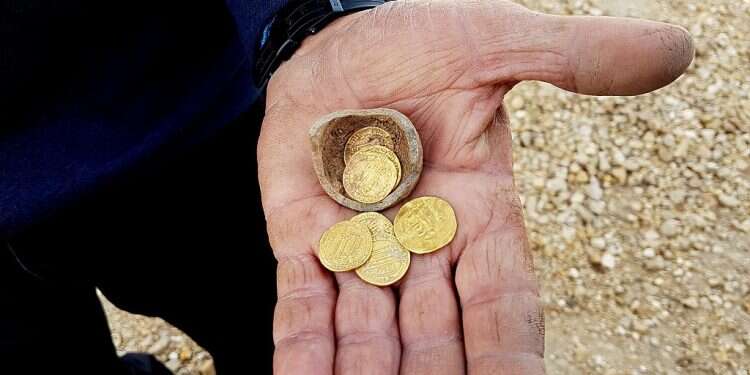A trove of gold coins dating back 1,200 years touched human skin for the first time in centuries this weekend after they were spotted at an archaeological excavation in Yavne, in central Israel.
Archaeologists excavating an ancient manufacturing area that was active for hundreds of years were surprised to find a small clay vessel containing gold coins from the 9th century CE. Researchers currently think that the treasure might have belonged to a potter.
Follow Israel Hayom on Facebook and Twitter
"All of I sudden I heard shouting," says Liat Nadav-Ziv, who is directing the dig with Dr. Eli Haddad of the Israel Antiquities Authority.
"I went out and saw Mark Mullokandov, a veteran IAA archaeologist, running toward the camp, all excited. We followed him and were surprised to see the treasure," she said.
Dr. Robert Cole, an IAA numismatics expert, gave the coins the once-over and the initial inspection indicates that they date to the beginning of the Abbasid Caliphate in the 9th century. The coins include one gold dinar of the Caliph Harun a-Rashid.
Video: Galit Tal / IAA
"The trove contains coins that we rarely see here in Israel. They are gold dinars from the Aghlabid dynasty – who ruled North Africa on behalf of the Abbasid caliphs in Baghdad. This is undoubtedly a Hanukkah present for us," Cole said.
Other discoveries at the dig, which is located southeast of Tel Yavne, include a "field of furnaces" that operated around the end of the Byzantine and early Islamic era, from the 7th century CE to the 9th century CE. These furnaces were used to make jugs, cooking pots, and bowls, all to be sold commercially. The gold coins were discovered inside a tiny jug that rested at the mouth of one of the furnaces. Archaeologists think they might have been payment for one of the potters, who used the jug as his personal cash register.
On the other side of the Tel Yavne site, the dig has uncovered the remnants of a large industrial facility dating back to the Persian Era (5th-4th centuries BCE) that was apparently used to make wine.
Haddad explained that an initial examination of the findings had revealed traces of grape seeds.
"The size of the compartments and the number of them indicate that wine was manufactured in commercial quantities, much more than would be needed to meet local demand of the residents of ancient Yavne," he observed.
The Israel Antiquities Authority is carrying out the Yavne dig as part of preparations to lay the groundwork for a new residential neighborhood.




